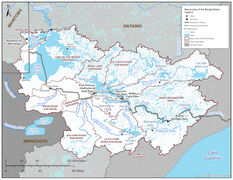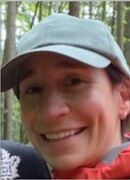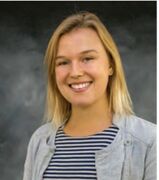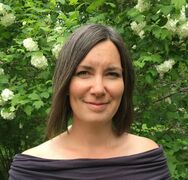 This watershed where we live, work and play, the international Rainy – Lake of the Woods watershed, is ecologically, geologically and politically complex. Part of the larger Lake Winnipeg watershed and Winnipeg River drainage basin, it’s a big watershed, spanning 400 km east to west and 260 km north to south. Almost 60% of the watershed is in Ontario, within the territory of the Anishinaabe Nation in Treaty #3 and homeland of the Northwestern Ontario Métis community – Métis Nation of Ontario; a small portion of the Canadian side is also in Manitoba. The remaining 40% is in Minnesota, inclusive of the Territories of 1854 Treaty Authority and Red Lake Band areas.
This watershed where we live, work and play, the international Rainy – Lake of the Woods watershed, is ecologically, geologically and politically complex. Part of the larger Lake Winnipeg watershed and Winnipeg River drainage basin, it’s a big watershed, spanning 400 km east to west and 260 km north to south. Almost 60% of the watershed is in Ontario, within the territory of the Anishinaabe Nation in Treaty #3 and homeland of the Northwestern Ontario Métis community – Métis Nation of Ontario; a small portion of the Canadian side is also in Manitoba. The remaining 40% is in Minnesota, inclusive of the Territories of 1854 Treaty Authority and Red Lake Band areas.
Governing and managing water in an area this large and complex requires a lot of cooperation and coordination. Water governance in the Namakan Reservoir, Rainy Lake, Rainy River and Lake of the Woods area involves agencies, states, provinces, and nations, including Indigenous nations, that have decision-making authority in the region.
In the first of our 2023 Ask an Expert webinars, we’ll take a look at how water management decisions for Rainy and Lake of the Woods are made, often in conjunction with people and groups managing water in the larger Winnipeg River system. We will go through a tour of who’s who and what we all do, helping to unpack some of the complexity around water governance in our region. This is the story of a remarkable example of effective multinational cooperation in governance and management – a story of which we can be proud and offer as an example to others.
In this webinar, you’ll hear from colleagues who work with government agencies in Canada and the US, assisting with water governance and management across the basin.
 Megan Garner is a regional engineer working with the National Hydrological Service through Environment and Climate Change Canada. She is a member of the International Joint Commission’s regional watershed board, the International Rainy – Lake of the Woods Watershed Board, where she also is the Canadian co-chair of the board’s Water Levels Committee. In addition to her role with the IJC board, Megan also serves as the Canadian representative on the Lake of the Woods Control Board and the International Lake of the Woods Control Board.
Megan Garner is a regional engineer working with the National Hydrological Service through Environment and Climate Change Canada. She is a member of the International Joint Commission’s regional watershed board, the International Rainy – Lake of the Woods Watershed Board, where she also is the Canadian co-chair of the board’s Water Levels Committee. In addition to her role with the IJC board, Megan also serves as the Canadian representative on the Lake of the Woods Control Board and the International Lake of the Woods Control Board.
 Maria Jawaid is a water policy analyst with Environment and Climate Change Canada. Maria serves as the Canadian secretary to the International Rainy – Lake of the Woods Watershed Board.
Maria Jawaid is a water policy analyst with Environment and Climate Change Canada. Maria serves as the Canadian secretary to the International Rainy – Lake of the Woods Watershed Board.
 Alexandra Lavictoire is a water resources engineer who works with the Lake of the Woods Control Board secretariat and serves as an engineering advisor to the International Rainy – Lake of the Woods Watershed Board and its Water Levels Committee. Alexandra is the Canadian co-chair of the watershed board’s Adaptive Management Committee and she is a member of the board’s Water Levels Committee.
Alexandra Lavictoire is a water resources engineer who works with the Lake of the Woods Control Board secretariat and serves as an engineering advisor to the International Rainy – Lake of the Woods Watershed Board and its Water Levels Committee. Alexandra is the Canadian co-chair of the watershed board’s Adaptive Management Committee and she is a member of the board’s Water Levels Committee.
 Abby Moore is a hydrologic engineer working with the US Army Corps of Engineers out of the St Paul, Minnesota district office. Abby is the US secretary to the International Rainy – Lake of the Woods Watershed Board and serves as an engineering advisor to the board and, like Alexandra and Megan, is a member of the Water Levels Committee.
Abby Moore is a hydrologic engineer working with the US Army Corps of Engineers out of the St Paul, Minnesota district office. Abby is the US secretary to the International Rainy – Lake of the Woods Watershed Board and serves as an engineering advisor to the board and, like Alexandra and Megan, is a member of the Water Levels Committee.
 Teika Newton is the International Watershed Coordinator, working with the Lake of the Woods Water Sustainability Foundation and the International Joint Commission to coordinate activities and connect agencies working around the basin. Teika is a past public member of the International Rainy – Lake of the Woods Watershed Board and Canadian co-chair of the Board’s Community Advisory Group, Engagement Committee and Adaptive Management Committee. Teika lives in Kenora.
Teika Newton is the International Watershed Coordinator, working with the Lake of the Woods Water Sustainability Foundation and the International Joint Commission to coordinate activities and connect agencies working around the basin. Teika is a past public member of the International Rainy – Lake of the Woods Watershed Board and Canadian co-chair of the Board’s Community Advisory Group, Engagement Committee and Adaptive Management Committee. Teika lives in Kenora.
In this webinar, we will:
- Provide an overview of the International Rainy – Lake of the Woods Watershed Board, who’s involved with it, and what it does;
- Take a more in-depth look at water levels regulation in the system, describing the role of the watershed board’s Water Levels Committee, and comparing and contrasting that with the Lake of the Woods Control Board and the International Lake of the Woods Control Board;
- Discuss the International Multi-Agency Arrangement, a table that brings together all the government and non-profit agencies working across the watershed on science, policy, and public engagement;
- Describe the role of the International Watershed Coordinator through the Lake of the Woods Water Sustainability Foundation, in conjunction with the International Joint Commission;
- And take audience questions.
This webinar has taken place View Now
Note that the session will be recorded for rebroadcast to the LOWWSF website.
